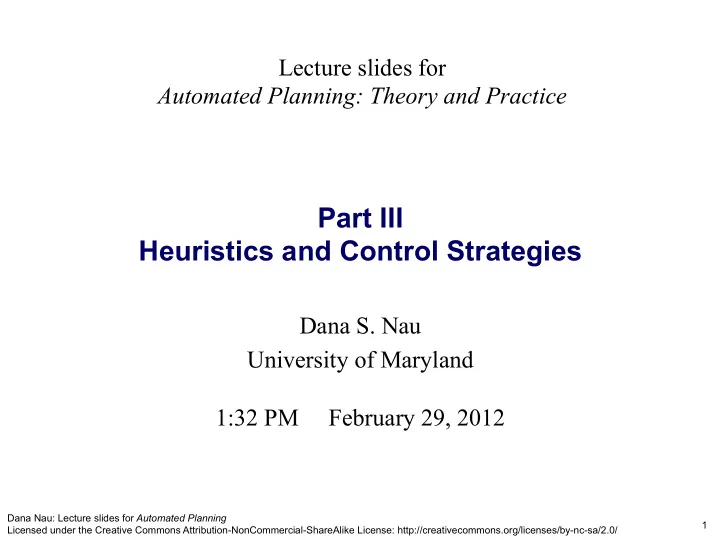

Lecture slides for Automated Planning: Theory and Practice Part III Heuristics and Control Strategies Dana S. Nau University of Maryland 1:32 PM February 29, 2012 Dana Nau: Lecture slides for Automated Planning 1 Licensed under the Creative Commons Attribution-NonCommercial-ShareAlike License: http://creativecommons.org/licenses/by-nc-sa/2.0/
Motivation for Part 3 of the Book ● Domain-independent planners suffer from combinatorial complexity ◆ Planning is in the worst case intractable ◆ Need ways to control the search Dana Nau: Lecture slides for Automated Planning 2 Licensed under the Creative Commons Attribution-NonCommercial-ShareAlike License: http://creativecommons.org/licenses/by-nc-sa/2.0/
Abstract Search Procedure ● Here is a general framework for describing classical and neoclassical planners ● The planning algorithms we’ve discussed all fit into the framework, if we vary the details ◆ e.g., the steps don’t have to be in this order Dana Nau: Lecture slides for Automated Planning 3 Licensed under the Creative Commons Attribution-NonCommercial-ShareAlike License: http://creativecommons.org/licenses/by-nc-sa/2.0/
Abstract Search Procedure ● Compute information that may affect how we do some of the other steps ● e.g., select a flaw to work on next, or compute a planning graph Dana Nau: Lecture slides for Automated Planning 4 Licensed under the Creative Commons Attribution-NonCommercial-ShareAlike License: http://creativecommons.org/licenses/by-nc-sa/2.0/
Abstract Search Procedure ● Divide current set of solutions into several sets to be explored in parallel ● e.g., B' ← { π . a | a is applicable to γ ( s 0 , π )} Dana Nau: Lecture slides for Automated Planning 5 Licensed under the Creative Commons Attribution-NonCommercial-ShareAlike License: http://creativecommons.org/licenses/by-nc-sa/2.0/
Abstract Search Procedure ● Remove some unpromising members of B ● e.g., loop detection, constraint violation Dana Nau: Lecture slides for Automated Planning 6 Licensed under the Creative Commons Attribution-NonCommercial-ShareAlike License: http://creativecommons.org/licenses/by-nc-sa/2.0/
Plan-Space Planning ● Refinement: select which flaw to work on next ● Branching: {the flaw’s resolvers} ● Pruning: loop detection ◆ recall this is weak for plan-space planning Dana Nau: Lecture slides for Automated Planning 7 Licensed under the Creative Commons Attribution-NonCommercial-ShareAlike License: http://creativecommons.org/licenses/by-nc-sa/2.0/
State-Space Planning ● Refinement: none ● Branching: {applicable or relevant actions} ● Pruning: loop detection ◆ Other branching & pruning techniques in Chapters 10 & 11 Dana Nau: Lecture slides for Automated Planning 8 Licensed under the Creative Commons Attribution-NonCommercial-ShareAlike License: http://creativecommons.org/licenses/by-nc-sa/2.0/
Planning-Graph Planning ● Wrap iterative deepening around Abstract-search ● Refinement: generate the planning graph, compute mutex info ● Branching: {sets of actions in action-level i that achieve goals at state-level i } ● Pruning: prune sets of actions that are mutex for number of levels = 0, 1, 2, … Dana Nau: Lecture slides for Automated Planning 9 Licensed under the Creative Commons Attribution-NonCommercial-ShareAlike License: http://creativecommons.org/licenses/by-nc-sa/2.0/
Search Heuristics ● Chapter 9: Heuristics in Planning ◆ Heuristics for choosing where to search next ◆ The heuristics in this chapter are domain-independent within classical planning Chapter 9 � Chapter 9 � Dana Nau: Lecture slides for Automated Planning 10 Licensed under the Creative Commons Attribution-NonCommercial-ShareAlike License: http://creativecommons.org/licenses/by-nc-sa/2.0/
Branching and Pruning Techniques ● Chapter 10: pruning via search-control rules ● Chapter 11: branching via hierarchical task decomposition ● These chapters discuss domain-configurable state-space planners ◆ Domain-independent planning engine ◆ Domain-specific information to control the search Chapter 11 � Chapter 10 � Dana Nau: Lecture slides for Automated Planning 11 Licensed under the Creative Commons Attribution-NonCommercial-ShareAlike License: http://creativecommons.org/licenses/by-nc-sa/2.0/
Branching Versus Pruning ● Two equivalent approaches: ◆ Generate all possible branches, then prune some of them ◆ Just don’t bother generating the ones that would be pruned ● Example: ◆ Domain-configurable implementations of the block-stacking algorithm from Chapter 4 ◆ Separate branching and pruning (Chapter 10) » Branch: generate all applicable actions » Prune: prune actions that build up “ bad ” stacks or tear down “good” ones ◆ Combined branching and pruning (Chapter 11) » Only generate actions that don’t build up “ bad ” stacks and don’t tear down “good” ones Dana Nau: Lecture slides for Automated Planning 12 Licensed under the Creative Commons Attribution-NonCommercial-ShareAlike License: http://creativecommons.org/licenses/by-nc-sa/2.0/
Recommend
More recommend